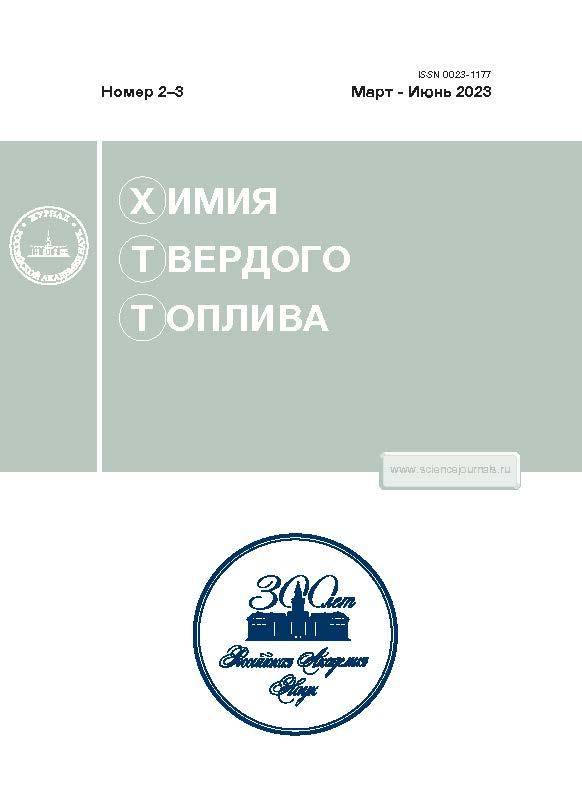Influence of In Situ Formed Nickel- and Cobalt-Containing Catalysts on the Mechanism of Conversion of Heavy Oil Asphaltenes
- 作者: Urazov K.K.1, Sviridenko N.N.1
-
隶属关系:
- Institute of Petroleum Chemistry, Siberian Branch, Russian Academy of Sciences
- 期: 编号 2-3 (2023)
- 页面: 86-91
- 栏目: Articles
- URL: https://bulletin.ssaa.ru/0023-1177/article/view/661910
- DOI: https://doi.org/10.31857/S0023117723020159
- EDN: https://elibrary.ru/CBLDOK
- ID: 661910
如何引用文章
详细
The influence of the amount of precursors of cobalt and nickel oxides on the composition and structure of catalytic cracking products of heavy oil from the Zyuzeevskoye field was studied. It was found that an increase in the amount of a loaded precursor led to the destruction of a larger amount of resin–asphaltene components and the yield of an IBP–360°C fraction. It was established that nickel-containing catalysts facilitated the destruction of 66% high-molecular-weight components, and cobalt-containing catalysts contributed to a low yield of by-products. The structural group analysis of initial oil asphaltenes and those formed after thermal and catalytic cracking was studied. A possible mechanism of the reactions was presented based on the experimental data.
作者简介
Kh. Urazov
Institute of Petroleum Chemistry, Siberian Branch, Russian Academy of Sciences
Email: urazovhh@gmail.com
Tomsk, 634055 Russia
N. Sviridenko
Institute of Petroleum Chemistry, Siberian Branch, Russian Academy of Sciences
编辑信件的主要联系方式.
Email: nikita26sviridenko@gmail.com
Tomsk, 634055 Russia
参考
- Guo K., Li H., Yu Z. // Fuel. 2016. V. 185. P. 886. https://doi.org/10.1016/j.fuel.2016.08.047
- Yakubov M.R., Abilova G.R., Yakubova S.G., Mironov N.A. // Pet. Chem. 2020. V. 60. P. 637. https://doi.org/10.1134/S0965544120060109
- Zhao F., Liu Y., Lu N., Xu T., Zhu G., Wang K. // Energy Report. 2021. V. 7. P. 4249. https://doi.org/10.1016/j.egyr.2021.06.094
- Kadkin O.N., Mikhailova A.N., Khafizov N.R., Yuan C., Varfolomeev M.A. // Fuel. 2022. V. 313. P. 123056. https://doi.org/10.1016/j.fuel.2021.123056
- Lakhova A., Petrov S., Ibragimova D., Kayukova G., Safiulina A., Shinkarev A. Okekwe R. // J. Pet. Sci. Eng. 2017. V. 153. P. 385. https://doi.org/10.1016/j.petrol.2017.02.015
- Yeletsky P.M., Zaikina O.O., Sosnin G.A., Kukushkin R.G., Yakovlev V.A. // Fuel Process. Technol. 2020. V. 199. P. 106239. https://doi.org/10.1016/j.fuproc.2019.106239
- Guo K., Hansen V.F., Li H., Yu Z. // Fuel. 2018. V. 211. P. 697. https://doi.org/10.1016/j.fuel.2017.09.097
- Уразов Х.Х., Свириденко Н.Н. // ХТТ. 2022. № 2. С. 46. [Urazov K.K., Sviridenko N.N. // Solid Fuel Chem. 2022. V. 56. P. 128. https://doi.org/10.3103/S0361521922020100]https://doi.org/10.31857/S0023117722020104
- Urazov K.K., Sviridenko N.N., Iovik Y.A., Kolobova E.N., Grabchenko M.V., Kurzina I.A., Mukhamatdinov I.I. // Catalysts. 2022. V. 12. P. 1154. https://doi.org/10.3390/catal12101154
- Nassar N.N., Hassan A., Pereira-Almao P. // Energy Fuels. 2011. V. 25. P. 1017. https://doi.org/10.1021/ef101230g












